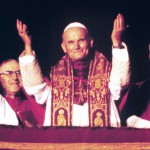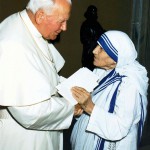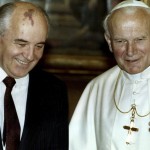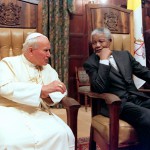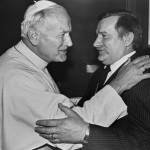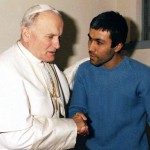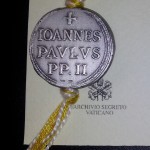Pope John Paul II
On April 27, 2014, in St. Peter’s Square at the Vatican, during the Divine Mercy Sunday mass, celebrated by Pope Francis, in the presence of Pope Emeritus Benedict XVI before the audience of a great number of priests and more than a million laymen, Pope John Paul II and Pope John XXIII were canonized.
John Paul II (secular name Karol Józef Wojtyła) was born on May 18 of 1920 in the town of Wadowice, South Poland, in the family of a former officer of the Austrian army. He was the youngest of the two children of Karol Wojtyła Elder and Emilia Kaczorowska, who died when the future Pope was only nine years old. Before he reached the age of twenty, Karol Wojtyła Junior was a full orphan. Karol studied well. When he finished school in 1938, on the eve of the Second World War, he entered the faculty of philosophy in the YagiellonianUniversity in Kraków.
At the same time, Karol became a member of a theater club “Studio 38.” During the German occupation, in order to avoid deportation to Germany, he dropped out of school and began to work in a quarry near Kraków, and then transferred to a chemical factory. In 1942, Karol Wojtyła signed up for an educational program of the underground spiritual seminary in Krakow. At the same time, he became one of the initiators of an active underground Rhapsodies Theater. In 1944, the archbishop of Kraków cardinal Stefan Sapieha due to safety reasons transferred Wojtyła together with other “illegal” seminary students to work in the eparchy administration in the archbishop’s palace, where Karol remained until the end of the war. When he was still young, he became a polyglot and spoke nine languages rather fluently – his mother tongue, Polish; Slovakian; Russian; Italian; French; Spanish; Portuguese; German; and English. And, of course, he also knew Latin.
On November 1 of 1946, Karol Wojtyła was ordained as a priest, and a few days later he went to Rome to continue his education in theology. In 1948, at the papal university “Angelicum,” he defended his thesis on the works of a Spanish mystic of the XVI century, reformer of the Carmelite Order, St. John of the Cross. Then he returned to Poland where he was appointed a helper of the parish priest in Niegović, near Gdów. The academic senate of the YagiellonianUniversity in Kraków acknowledged the diploma Wojtyła received in Rome and honoured him with a doctorate. In 1953, at the theological faculty of the YagiellonianUniversity in Kraków, Wojtyła defended his thesis on of the possibility of founding a Catholic ethic on the ethical system of German philosopher Max Scheler.
Later, Karol Wojtyła became a professor of ethics and moral theology at the Krakow spiritual seminary and at the theological department of the CatholicUniversity in Lublin. On July 4, 1958, by the appointment of pope Pius XII, father Wojtyła became the Auxiliary Bishop of Krakow Archdiocese, and on September 28 of 1958, he was ordained to the Episcopate as a bishop. Between 1962 and 1964, he participated in all four sessions of the Second Vatican Council, called by Pope John XXIII, being one of the youngest of its participants. Because of this work one year later (on January 13, 1964) he was ordained as the Archbishop of Kraków. On June 28, 1967, Pope Paul VI made him a Cardinal. In August of 1978, after the death of Paul VI, Karol Wojtyła participated in the Conclave that chose Pope John Paul I, but the latter died only 33 days after the election. In October there was another Conclave. Its participants found themselves divided into two camps that supported two Italian candidates – Giuseppe Siri, the Archbishop of Genoa, known for his conservative views, and more liberal Giovanni Benelli, the Archbishop of Florence. Eventually, Wojtyła became a compromise figure and was elected the Pope. As he ascended to the throne, Wojtyła accepted the name of his predecessor and became John Paul II. He became the first Polish Pope and the first non-Italian Pope since 1523.
Just like his predecessor, John Paul II tried to make his office more simple, stripping it of many royal attributes. In particular, when speaking about himself, he used the pronoun “I” instead of “We,” which is accepted among the reigning monarchs. The Pope refused from the ceremony of crowning, holding a simple inauguration instead. He did not wear the Pope’s tiara and always tried to emphasize the role, which is designated in the Pope’s title, Servus Servorum Dei (slave of the slaves of God).
In 1979, John Paul II met for the first time with the Minister of Foreign Affairs of USSR A. A. Gromyko. It was an unprecedented event, in view of the absence of diplomatic relations between the Soviet Union and Vatican. On December 1, 1989, the Pope met with the Soviet leader M. S. Gorbachev, and already on March 15, 1990, the diplomatic relationships between USSR and Vatican were established. On November 5, 2003, the Pontific received the President of Russia V. V. Putin at the Vatican.
On January 25 of 1979, the Pope’s visit to Mexico started. It was the first of 104 foreign visits of the Pontific. In the summer of 1979, John Paul II visited his native Poland. His election to the Holy Throne gave a spiritual impetus to the struggle of Polish people against the communist regime and founding of the Solidarity move. Later, the Pope visited his homeland seven more times, but never gave any ground to accuse him of inciting the opposition to a revolution. In the late 1980s, he played an important role when the change of the regime in Poland took place without a single shot. For many people John Paul II is one of the symbols of the epoch of communism’s collapse, along with M. S. Gorbachev.
John Paul II was wide open to contact representatives of other confessions. In 1980, the Queen of the United Kingdom Elizabeth II made a state visit to Vatican (the Queen is also the Head of the Anglican Church). It was a historic visit, since for many centuries the British monarchs and Roman Pontifics were bitter enemies. Queen Elizabeth II was the first of British monarchs to come to Vatican with a state visit and even invited the Pope to the United Kingdom for a pastoral trip to over four million of British Catholics. In 1982, the Pope of Rome met the Archbishop of Canterbury and officiated at a corporate service together with him. In August of 1985, at the invitation of King Hassan II, the Pope spoke in Morocco before the audience of fifty thousand young Moslems. He spoke about misunderstanding and enmity, which existed earlier in the relationships between Moslems and Christians, and called for the establishment of “peace and unity between the people and the nations that make one community on the earth.” In April of 1986, Pope John Paul II for the first time in the history of the Catholic Church stepped over the threshold of a synagogue, where, sitting next to the chief Rabbi of Rome, he spoke the phrase which became one of his most often quoted sayings, “You are our beloved brothers, and, one may say, our elder brothers.” In October of 1986, in Assisi there was the first inter-religious meeting, when to the invitation of the Pontific to discuss the problems of inter-confessional relationships 47 delegations from different Christian denominations and representatives of 13 other religions responded. On May 6, 2001, John Paul II became the first Pontific who visited a mosque. On May 7 of 1999, John Paul II for the first time visited an Orthodox country – Romania. In 2001, the Pope made an official visit to Greece – the first time ever – since the split of the Western and EasternChurches. One dream that had not come true though for John Paul II, was a trip to Russia, which was objected by the Moscow Patriarchy, which accused the Roman Catholic Church of expansion to the traditional territory of the Russian Orthodox Church.
On May 13, 1981, the papacy of John Paul II nearly tragically ended when an attempt of assassination was made against him in the Square of St. Peter in Rome. Later, John Paul II came to believe that the Holy Virgin Herself fended off the bullet away from him with Her own hand. The assassination was attempted by a member of the Turkish ultra-nationalist group “Grey Wolves” Mehmet Ali Ağca. He came to Italy after escaping from the Turkish prison, where he served his sentence for a murder and bank robberies. Ağca wounded John Paul II in his chest and arm and was captured. In 1983, the Pope visited Ağca in his prison, who was sentenced for life. What exactly they spoke about has remained a mystery, but the Pope told journalists that he forgave Ağca. In 1984, Ağca testified that the assassination was organized by the Bulgarian and Soviet secret services. Three Bulgarians and three Turks were arrested, who were purportedly involved in the assassination attempt, but because of the lack of evidence they were released. Later, at the Pope’s request, Ağca was pardoned by the Italian authorities and given over to the Turkish justice. In 2005, Ağca stated that some cardinals in Vatican were involved in the attempt. On March 2, 2006, some excerpts were publicized from a report of the Italian parliament’s committee that looked into the investigation of the circumstances of the assassination attempt against John Paul II. The committee’s chairman, senator Paolo Guzzanti informed the press of the connection between the attempt to eliminate John Paul II and USSR’s leadership. The report was based on the information made public by the former head of the archive department of the Soviet KGB, Vasili Mitrokhin, who emigrated to the United Kingdom in 1992.
Among his predecessors, John Paul II stand out because of the mere fact of his numerous apologies for the mistakes made by some Catholics in the course of their history. Even at the time of the Second Vatican Council in 1962, the Polish bishops together with Karol Wojtyła published a letter of Reconciliation to the German bishops, saying, “We forgive and ask for forgiveness.” And after becoming the Pope, John Paul II made a repentance on behalf of the entire Western Christian civilization for the crimes of the Crusades’ times and Inquisition. In October of 1992, the Roman Catholic Church rehabilitated Galileo Galilei; and in October of 1993 it did the same for Nicolaus Copernicus. In August of 1997, John Paul II acknowledged the church’s guilt for the mass killings of Protestants in France during St. Bartholomew day’s massacre on August 24 of 1573, and in January of 1998, he made a decision to open the archives of the Holy Inquisition. On March 12, 2000, during a traditional Sunday mass in Saint Peter’s Cathedral, John Paul II made a public repentance for the sins of the Catholic Church. He asked for forgiveness and acknowledged the guilt of the Church in eight sins: persecution of the Jews, the Great Schism and religious wars, Crusades and war-justifying theological tenets, despising the minorities and the poor, and justification of slavery. Never in the history of the mankind any religion or confession would make such a repentance. John Paul II acknowledged the accusations against the Catholic Church – in particular, it was accused of being silent during the events of World War II and Holocaust, when Catholic priests and bishops limited themselves to rescuing Jews and other people persecuted by the Nazi.
In the middle of the 1990s, John Paul II’s health began to deteriorate. In 1992, a benign intestinal tumor was removed from him. On April 29, 2004, he slipped on the floor of his bathroom, fell, and broke his hip. From the same time he began to suffer from Parkinson’s disease. Despite his physical weakness, John Paul continued making foreign trips. In February of 2005, the Pope was taken to a hospital with an acute form of laryngotracheitis, where he underwent a tracheotomy. But even when he was released from the hospital, he could not participate in the worship services during the Holy Week and could not speak a word during the traditional address to the believers after the Passover mass. On the night of April 2, 2005, John Paul II went to be with the Lord.
The Pope of Rome Benedict XVI started the process of beatification of his predecessor – John Paul II. The news was announced by Benedict XVI at the gathering of priests at Saint John Lateran’s Basilica in Rome. The process of beatification requires that a miracle must occur. It is believed that several years ago John Paul II healed from Parkinson’s disease a French nun Marie Simon-Pierre. On May 1 of 2011, Pope Benedict XVI beatified John Paul II.
The decision of John Paul II’s canonization was made after the Cardinals’ Consistory, held by a new Pope – Francis, on September 30, 2013. On July 3, the Congregation for the Causes of Saints of the Holy Throne made a declaration that the second miracle at the intercession of the Pontific, which was necessary for his canonization, took place on May 1 of 2011. The miracle happened in Costa Rica to a woman named Floribeth Mora Dias, who was healed from terminal brain aneurism because of the prayer and intercession of John Paul II.
On April 27, 2014, John Paul II was canonized by Pope Francis.
In the tradition of the Western Christian Church, according to the edict of Pope Urban VIII issued in 1642, there is a difference between the process of beatification (declaring someone as “blessed,” or beatified) and canonization (declaring someone as a saint). Later, Pope Benedict XVI established the requirements that every candidate must meet: his writings should be in line with the teaching of the Church, the virtues he manifested must be extraordinary, and the facts of miracles that took place at his intercession must be documented or confirmed by the testimonies of witnesses.
It takes at least two miracles at the intercession of the deceased for his canonization. When martyrs are beatified and canonized miracles are not required.
The matters of canonization are considered by the Congregation for the Causes of Saints in Vatican, which examines presented materials and sends them, in the case of positive preliminary conclusion, to be approved by the Pope, after which in Saint Peter’s Cathedral the icon of the newly canonized one is presented.
John Paul II himself beatified and canonized more people than all of his predecessors since the XVIth century. Beginning from 1594 (after Pope Sixtus V in 1588 introduced the Apostolic Constitution Immensa Aeterni Dei, regulating, among other things, the process of canonization) until 2004, there were 784 people canonized, 475 out of that number – during the pontificate of John Paul II. 1338 people were beatified by Pope John Paul II.
Materials were used from the following web-sources: WIKIPEDIA and http://monarchy.nm.ru

